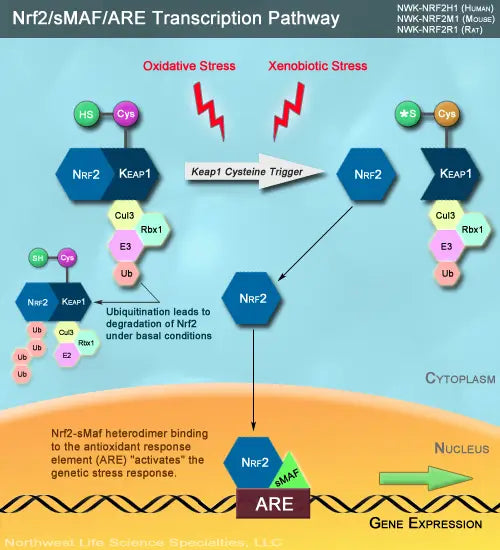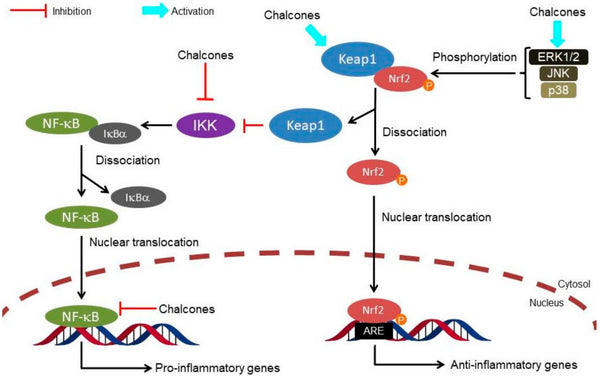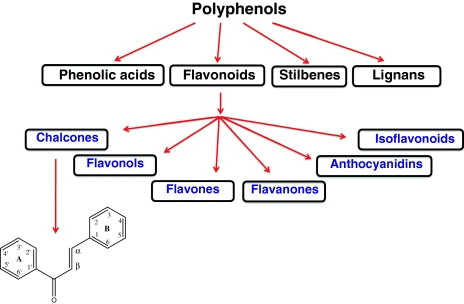NRF2 is a transcription factor that is activated by oxidative stress. It is a key regulator of the antioxidant response. Nrf2 = The Antioxidant Master Switch. Calorie restriction, exercise, phytochemicals, intermittent fasting, cold exposure and heat all activate it. Read more below!
Nrf2 (nuclear factor erythroid-derived 2 like protein) is a transcription factor commonly found in a cell’s cytoplasm. It activates the transcription of over 500 genes in the human genome. When Nrf2 is activated it goes into the nucleus to perform its main functions. It binds to the antioxidant response elements (ARE) located in the promoter region of genes encoding many phase II detoxifying or antioxidant enzymes and related stress-responsive proteins.

Image source: Northwest life Science Specialties.
Under normal conditions, Nrf2 is repressed by Keap1, which is an adaptor protein for the degradation of Nrf2. But during oxidative stress, Nrf2 is derepressed (or activated) and this activates the transcription of protective genes. The Keap1-Nrf2 system plays a role in inflammation-associated pathogenesis.
The Nrf2 signaling pathway and its subsequent induction of cytoprotective (protection of cells from harmful agents) protein expression is the main cellular defense mechanism against oxidative and electrophilic stress. Therefore, interactions of Nrf2 with other signaling components regulate the efficiency of the cellular stress response. One of these is autophagy (read a comprehensive article on autophagy here).
The health benefits of Nrf2 are for example:
- Ameliorates oxidative stress and reduces inflammation
- Protects from neurodegeneration and possibly from neurodegenerative diseases
- Supports cardiovascular function, may prevent atherosclerosis and cardiovascular disease
- Combats insulin resistance and obesity and can prevent diabetes mellitus
- Regulates cell cycle homeostasis, cytoprotection and innate immunity when cells are under stress
- May protect from cancer and tumors and increases cytoprotection
- Protects mitochondria from oxidative stress and injury likely through direct interaction with mitochondria
- May prevent from various liver diseases and help with liver detoxification pathways
- Plays a key role in the stress resilience which is involved in the pathophysiology of mood disorders and depression
Lifestyle factors that activate Nrf2
Lifestyle and other factors activating Nrf2 include heat and cold exposure – when practiced in one session as heat alteration may produce the best results (see a specific article on Heat Alteration). Physical exercise is also a known Nrf2 activator. For example acute aerobic exercise elicits activation of nuclear Nrf2, regardless of exercise intensity. But higher-intensity exercise results in greater activity of glutathione reductase.
Nrf2 signaling in sedentary older adults can also be restored to a degree with moderate exercise training. To conclude, episodic increases in oxidative stress induced through bouts of acute exercise stimulate Nrf2 activation and when applied repeatedly, it leads to upregulation of endogenous antioxidant defenses and overall greater ability to fight oxidative stress.
Other lifestyle factors increasing Nrf2 include fasting, calorie restriction, and the activation of ketosis (check Biohacker's Guide to Ketosis here). It should be also mentioned that well functioning mitochondria also almost automatically means a well-functioning Nrf2 signaling. It is also known that loss of Nrf2 leads to impaired mitochondrial function.
Nutritional factors supporting Nrf2
There are multiple nutritional compounds and components that support the function and activation of Nrf2. Several natural antioxidants have emerged as possible Nrf2 pathway activators amongst which chalcones are very active ones. Chalcones constitute an important group of natural compounds that are especially abundant in fruits (e.g., citruses, apples), vegetables (e.g., tomatoes, shallots, bean sprouts, potatoes) and various plants and spices (e.g., licorice),—many of which have been used for centuries in traditional herbal medicine. They activate Nrf2 signaling pathway, expression of Nrf2-regulated antioxidant genes, induce cytoprotective proteins and upregulate multidrug resistance-associated proteins.

Image: Multi-target interaction of chalcones on cross-talk between Nrf2 and NF-κB response pathways involved in inflammation.
Source: de Freitas Silva, M. et al. (2018). The Keap1/Nrf2-ARE pathway as a pharmacological target for chalcones. Molecules 23 (7): 1803.
|
Chalcone compound |
Sources |
|
Trans-chalcone |
A flavonoid precursor |
|
Xanthohumol |
Humulus lupulus or Hops |
|
Licochalcone E |
Licorice root |
|
Safflor Yellow A |
Various yellow colored foods |
|
Lophirones B & C |
Lophira lanceolata or dwarf red ironwood |
|
Isoliquiritin |
Licorice root |
|
Isoliquiritigenin |
Licorice root |
|
Isosalipurposide |
Helichrysum arenarium or dwarf everlast flowers |
|
Naringenin |
Various foods such as cocoa, Greek oregano, sour orange, grapefruit etc. |
|
Cardamonin |
Alpinia katsumadai & Alpinia conchigera |
|
Butein |
Various plants such as Butea dahlia, Coreopsis and Searsia |
|
HMC (Hesperidin methyl chalcone) |
Citrus fruits, especially in their peels, such as orange peels |
|
Flawokawains A, B & C |
Piper methysticum (Kava-kava) |

Image: Main polyphenol family members.
Source: Orlikova, B. & Tasdemir, D. & Golais, F. & Dicato, M. & Diederich, M. (2011). Dietary chalcones with chemopreventive and chemotherapeutic potential. Genes & Nutrition 6 (2): 125–147.
Flavonoids can be further divided into various subclasses of which chalcones, flavonols, flavones, flavanones, anthocyanidins, and isoflavonoids are the most common. See a comprehensive list of flavonoids in Biohacker’s Handbook’s Nutrition Chapter.
Other foods and compounds that are known to activate Nrf2:
- Sulforaphane found in broccoli and other cruciferous vegetables (see Bioahcker's Brain Nutrition Guide here)
- Highest concentration found in broccoli sprouts as glucoraphanin
- Sulforaphane regulates the expression of over 200 genes in Nrf2 pathway
- Quercetin found in raw red onions (highest concentration in vegetables) and capers (most concentrated source), apples, citrus fruits, raspberries, green leafy vegetables, watercress, sorrel, tea and other plants
- Vitamin C and bromelain increase the absorption of quercetin from food (and supplements)
- Curcumin extracted from turmeric root
- Upregulates Nrf2 by repressing Keap1 expression in insulin resistance
- Has antiviral potential via Nrf2
- Resveratrol, a natural polyphenol derived from grapes, berries, plums and peanuts. The highest concentrations of resveratrol are found in the Japanese knotweed Polygonum japonicum.
- Silymarin (also known as milk thistle) and its flavolignans
- Epigallocatechin gallate (EGCG) is the most abundant and effective green tea catechin and polyphenol that activates Nrf2 and its downstream molecules
- Phenolic constituents of coffee activate the Nrf2 pathway
- Roasting of green coffee increases the ability to activate Nrf2
- Dark roast coffee is more potent than light roast coffee
- Fermented foods and beverages with Lactobacillus plantarum, Lactobacillus brevis and Lactobacillus collinoides convert common phenolic acids found in fruits and vegetables to alkyl catechols, which support the Nrf2 pathway
- Luteolin (a flavonoid) found in celery, parsley, radishes, peppers, apple skins, greens, red lettuce, and artichoke
- Plant flavone apigenin, found in parsley, chamomile, celery, vine-spinach, artichokes and oregano, activates Nrf2 pathway’s anti-oxidative signaling
- Carotenoids such as lycopene, lutein and zeaxanthin activate Nrf2 antioxidant system
- Sodium butyrate is a short-chain fatty acid obtained by fermentation of dietary fiber via intestinal microbiota. It has been found to activate the Nrf2 antioxidant pathway. It is also found in ghee and butter (where the name comes from) and can be used as a supplement.
///
Have you heard of Nrf2 before? What did you learn reading this article? Tell us in the comments!
Order our new book here: the Resilient Being.





